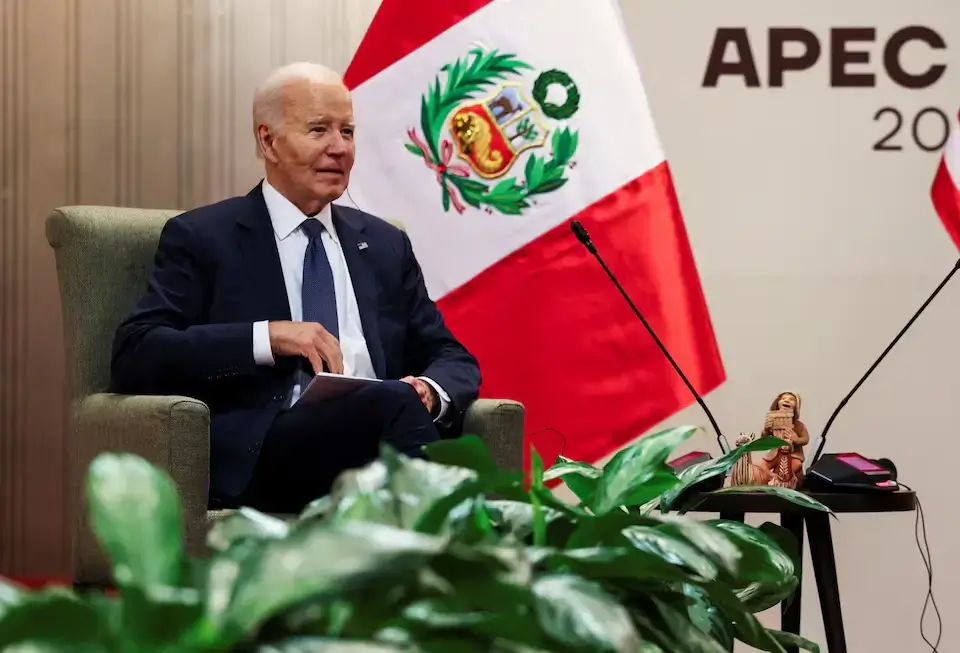High-Stakes Summit at APEC: U.S.-China Relations in Focus
U.S. President Biden and Chinese President Xi met at the APEC forum in Lima, Peru, for their first dialogue in seven months, amid rising tensions in U.S-China relations.
Key Tensions Dominating U.S.-China Relations Talks
The meeting focused on a range of contentious issues that have worsened bilateral ties in recent years:
- Cybersecurity Concerns: The U.S. accuses China of cyber attacks on government agencies, campaigns, and infrastructure, with the Biden administration calling for accountability and enhanced defenses.
- Taiwan Tensions: China has intensified military exercises near Taiwan, while the U.S. continues to support Taiwan with arms and political backing, increasing tensions with Beijing.
- Support for Russia: China’s support of Russia in the Ukraine conflict is a key issue, with the U.S. seeing it as a challenge to efforts to diplomatically isolate Moscow.
- Trade and Technology Controls: The Biden administration has imposed new trade restrictions on China, focusing on semiconductors and critical technologies to limit military advancements.

Taiwan Issue Takes Center Stage in U.S.-China Relations
The situation surrounding Taiwan was a focal point of the discussions, as tensions remain high:
- Diplomatic Visits: Taiwan President Lai Ching-te plans visits to Hawaii and possibly Guam to strengthen ties with the U.S., risking further tensions with Beijing over sovereignty claims.
- Biden’s Engagement: At the APEC summit, Biden met with Taiwan’s representative, reinforcing U.S. support for Taiwan despite Beijing’s objections and highlighting Washington’s commitment to Taipei.
- China’s Stance: Beijing insists Taiwan is an integral part of China, with President Xi reaffirming that any push for Taiwanese independence will face strong countermeasures.
- U.S. Arms Sales: The U.S. continues to be Taiwan’s primary supplier of defensive weapons, a policy that has fueled Chinese military responses, including aggressive naval patrols and air incursions near Taiwan.
Trump’s Upcoming Presidency and Impact on U.S.-China Relations
The imminent transition to a Trump administration has added another layer of complexity to the talks:
- Proposed Tariffs: Trump plans a 60% tariff on Chinese imports, a move likely to escalate trade tensions and further strain economic relations with China.
- Appointment of China Hawks: Trump’s potential cabinet picks, including Marco Rubio as Secretary of State and Mike Waltz as National Security Adviser, are known for their tough stance on China.
- Policy Uncertainty: The transition period raises uncertainty about U.S. policy toward China, with Biden seeking smoother relations and Trump’s rhetoric signaling a more confrontational approach.
China’s Latin American Diplomacy and U.S.-China Relations
President Xi’s visit to Peru is part of a broader diplomatic effort in Latin America:
- Trade Agreements: Xi signed a free-trade agreement with Peru to boost economic ties, focusing on agriculture, mining, and energy sectors for expanded trade and resource access.
- Strategic Projects: China inaugurated the Chancay deep-water port in Peru, a key Belt and Road Initiative project to enhance trade connectivity and expand its influence in Latin America.
- Upcoming Visits: Xi is scheduled to visit Brazil next, where he will meet with President Luiz Inácio Lula da Silva to discuss further economic cooperation and potential joint projects.
- APEC 2026: China has announced plans to host the APEC forum in 2026, signaling its intent to play a leading role in regional economic integration and diplomacy.
Economic and Strategic Implications for U.S.-China Relations
The meeting between Biden and Xi underscored broader concerns about the evolving power dynamics between the U.S. and China:
- Military Presence: The U.S. is wary of China’s growing military presence in Latin America, including increased naval activities and potential basing agreements with regional allies.
- Technology and Trade Tensions: Ongoing disputes over technology exports, tariffs, and trade barriers continue to dominate U.S.-China economic relations, impacting global supply chains and economic stability.
- Regional Resources: China’s increasing investments in Latin American commodities, such as lithium and rare earth minerals, raise questions about U.S. influence in the region traditionally seen as its sphere of influence.
The dialogue in Peru highlights the complex relationship between the U.S. and China, marked by competition, cooperation, and uncertainty. As Trump prepares to take office, the future of U.S.-China relations remains in flux, with potential for both heightened confrontation and strategic engagement.

